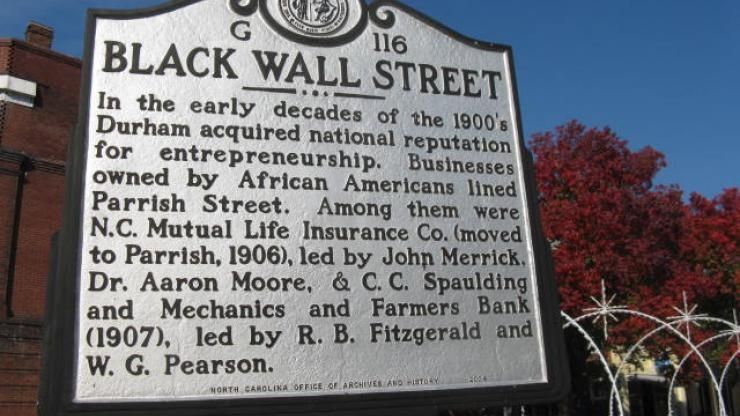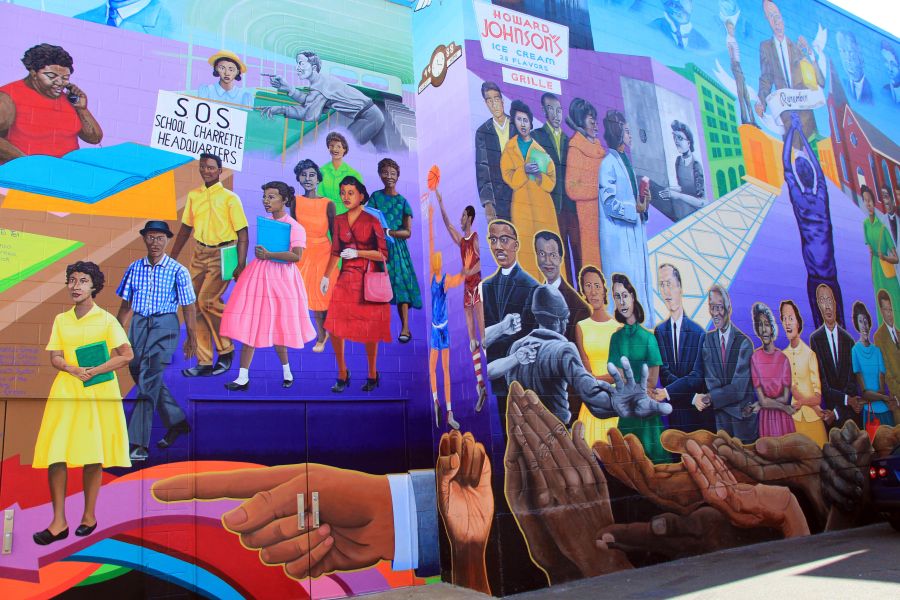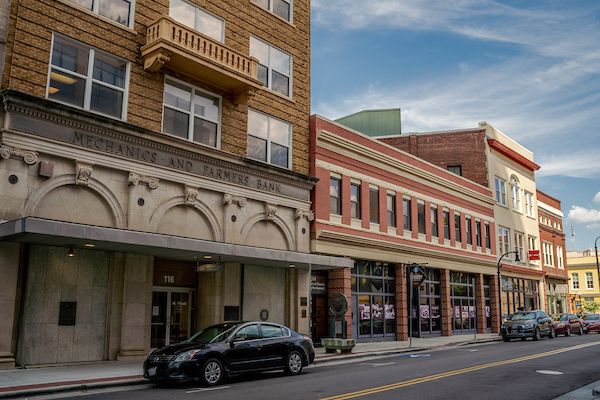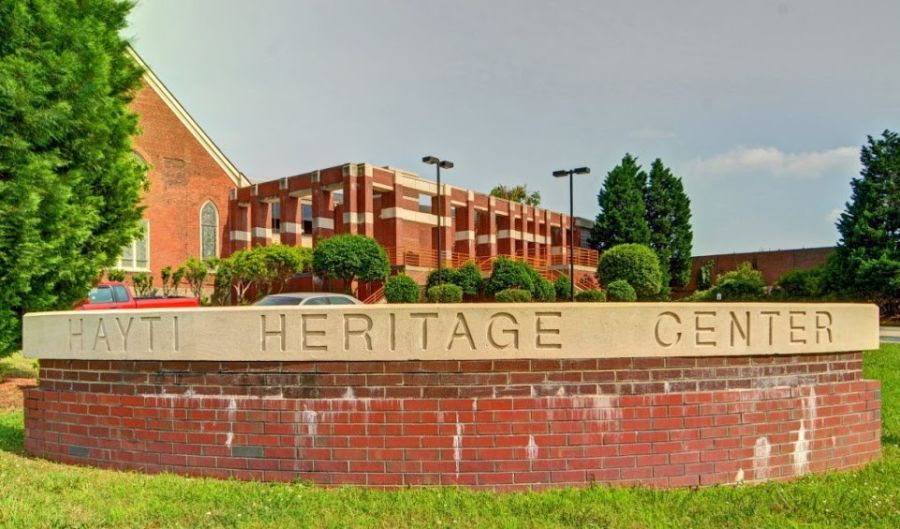A Diverse Historical Perspective
Travel back in time to discover the historical foundation of the city in just 72 hours.
Much has changed since Native Americans settled in what is now Durham along the Eno River in the 1700s. Much has not. In ways both conventional and uncommon, our path has been paved by powerful historic figures and events that have cultivated the proud community of today. Experience three state historic sites, a rich civil rights history and a citizenry that honors and preserves its heritage.

A marker on Parrish Street commemorates the site of Durham's Black Wall Street, a hub of Black entrepreneurship that began flourishing in the late 1800s and is still alive today. Photo: Discover Durham
Day 1: Discover History in the Heart of Downtown
Discover public art and entrepreneurial landmarks in the heart of downtown Durham
Morning
Wake up at one of the three boutique hotels downtown – The Durham Hotel, Unscripted Durham or 21c Museum Hotel – and find yourself in a restored building. The Durham and 21c are former bank buildings, while the modern Unscripted was formerly a motor lodge. The Durham's first-floor lobby is a coffee shop by day – the famous Markola coffee soda can't be missed and housemade pastries will fuel your morning. Once you're ready to get out and go, be sure to stop in at the Visitor Info Center at 212 W. Main St. – it's located in the Trust Building, Durham's first skyscraper! – to pick up maps and a printed walking tour with more context around historical markers, architecture and more.
Day
After unpacking and getting the lay of the land, enjoy an afternoon and early evening around the city center, where you’ll find historic signs, murals and businesses that commemorate our past and promising future. Start at the Museum of Durham History, a 21st-century museum with a rotating schedule of events, exhibits, interactive displays and knowledgeable locals who engage with history through storytelling.
If you’re looking for evidence of Durham’s contributions to the Civil Rights era, there’s no shortage of them. In the former home of the Black-owned NC Mutual Life Insurance Company, hangs a marker from the Royal Ice Cream Parlor marker that commemorates one of the first sit-ins of the Civil Rights Movement. Provident 1898 is an inclusive co-working and community space that supports entrepreneurs, change-makers and creatives within the Mutual Life Building, which was the tallest Black-owned building in the U.S. when it was built.

Durham Civil Rights Mural. Photo: Discover Durham
Just down the street near the Durham Arts Council, you’ll find the work of over 30 community members and local artist Brenda Miller Holmes — our Civil Rights Mural. Powerful figures are immortalized there: Martin Luther King, Jr. (who spoke in Durham seven times); Julian Francis Abele, the African American architect who designed Duke Chapel and much of Duke University; Virginia Williams, a member of the Royal Seven; and Ann Atwater, a local activist and community leader commemorated in The Best of Enemies feature film for her work to integrate Durham Public Schools. Mere blocks away, another historical figure is honored in a mural by artist Brett Cook: Pauli Murray. A force for human rights, Pauli was a queer, Black person of faith who is still honored today for standing at the intersection of marginalized identities while advocating for the values of equality and reciprocity in the community. Pauli grew up in Durham, the granddaughter of Robert and Cornelia Fitzgerald, who built the home where Pauli was raised in 1898. Now a National Historic Landmark, the Pauli Murray Family Home now houses the Pauli Murray Center for History and Social Justice, a community center that honors Murray's life through history and by supporting and inspiring new generations of activists. Currently, visitors can experience an outdoor exhibit, and the center has plans to reopen after a renovation. Check the Center's schedule for periodic walking tours.
Pauli’s likeness sits adjacent to the Carolina Theatre, the epicenter of desegregation efforts. Though built in 1926 as the only theatre in the area to admit Blacks and whites, the communities were still segregated within its walls. Decades later in the early 1960s, the Carolina Theater was host to protests until its full integration in 1963.
A few steps from the theatre’s courtyard is Black Wall Street, where Durham’s history has been crafted by a community of entrepreneurs. A hub of Black-owned businesses that blossomed during the early 1900s, Durham's tireless communities of color bolstered the construction of early Durham, built from the ground up with bricks made by the Black-owned Fitzgerald Brick Company. North Carolina's oldest Black-owned bank was established on Black Wall Street despite the searing systemic wounds of Jim Crow America, and a new generation of Black-owned businesses stands on the legacy of excellence that came before them. Be sure to view the publicly available exhibit on "The Black Wall Street of America," and visit the six historical markers commemorating this history on Durham's Parrish Street.

Mechanics and Farmers Bank on Durham's Parrish Street. Photo:
Dining:
For lunch, stop by King's Sandwich Shop for a hot dog, burger, fries and a shake at the iconic stand that has been operated as a family-run icon since 1942. Just down the street, you'll find more options for the whole family at Durham Food Hall, located on the original site of Liberty Warehouse. A walk around the block to the corner of Rigsbee Avenue and Corporation Street reveals a part of the original brick facade of the tobacco auction house, complete with original painted signage and a mural depiction of the historic site.
As dinner approaches, head to Brightleaf Square, which is comprised of two tobacco warehouses constructed in 1904. In this monument to the past adapted for the future, plenty of shopping, food and drink options operate between the historic walls. One of the region's most prolific restauranteurs, Giorgios Bakatsias, opened Nikos, a Greek restaurant that's an ode to a Brightleaf Square restaurant from over a decade ago.
Day 2: Buckle up to adventure beyond the skyline
Tour three state historic sites and acres of artifacts within a short drive of downtown.
Morning:
Use today to venture a bit further from the city center — and centuries back into Durham’s past. In 1865, Union and Confederate armies met at Bennett Place, a small farmhouse in northern Durham that marked the largest troop surrender and the effective end of the Civil War. Quick tip: Bennett Place was also included in The New York Times's most recent recommended itinerary for a 36-Hour Durham trip.
Visitors can guide themselves around the extensive grounds of Historic Stagville, one of the largest sites of plantation slavery in North Carolina, owned by the Bennehan-Cameron family. The Bennehan-Cameron family owned approximately 30,000 acres of land and claimed ownership over about 900 people who were enslaved on this property. The property is now entirely dedicated to teaching about the lived experiences, cultural traditions, family lives and resilience of some of the Black people who were enslaved there, and a guided tour is an enriching, if challenging, way to learn about Durham's past.

Historic Stagville
Afternoon:
Yet another nationally recognized historic site sits at Duke Homestead, where Durham’s future leaders rapidly launched North Carolina and the South into the Industrial Revolution and beyond. This 19th-century farm is named for Duke University’s namesake, Washington Duke, who was perhaps Durham’s most notable industrial leader. Washington Duke first grew and processed Durham’s lucrative crop: tobacco. Make time to visit the site’s tobacco museum, Washington Duke’s home and other historic structures.
North of the Duke Homestead lies West Point on the Eno, a 388-acre park consisting of a two-mile stretch of the scenic Eno River and West Point Mill, one of the area's longest-running and most prosperous mills. Make time to see the McCown-Mangum House, a restored Greek revival farmhouse; and the Hugh Mangum Museum of Photography, with its permanent exhibit of Mangum’s images and equipment. The park is open daily from 8 a.m. to sundown year-round.
Day 3: Just your luck—history strikes twice at Durham’s restored community hubs
From Hayti to the American Tobacco Campus, discover Durham’s resilience brick by brick
Morning:
Filled with Black hospitals, schools, theatres and businesses, the Hayti community was home to the cornerstone of the most prosperous African American community in the United States. Although a Durham highway built decades ago has since cut off the community from its vital artery to downtown Durham, the Hayti Heritage Center still symbolizes the dignity and resolve of a resilient people. Stop by the Hayti Heritage Center, part of the NC Civil Rights Trail, to learn more about the history of the Hayti community and to take in one of the events that promote the African American experience.

Hayti Heritage Center
Afternoon:
Make your way back towards the American Tobacco Campus, a revitalized district that was once the heart of Durham’s booming tobacco industry. When baseball is in season, enjoy America's favorite pastime at a Durham Bulls baseball game. Take time to walk through the stadium – there's a great exhibit on the history of the baseball card and its ties to Durham.
Some of Durham’s celebrated restaurants are located in and around American Tobacco Campus. You can break outside American traditions and try African Bantu tapas at Ekhaya, a fine-dining restaurant from the husband-and-wife team behind the local favorite Zweli's Kitchen which serves Zimbabwean fare. If Cajun and Creole flavors are more your thing, try Seraphine just across the courtyard from Ekhaya.
Assuming you hit the ground running, that’s more than enough adventure to fill a short 72-hour history tour of Durham (and we haven’t even gotten to our culinary and family guides)! There’s undoubtedly more to see and do, so you’re welcome back to do your thing in Durham any time.
ADDITIONAL TRIP-PLANNING RESOURCES
Here's everything you need to know about where to stay, what to explore, and how to discover Durham!
discoverdurham.com
Official Durham website for visitors and newcomers. Features searchable event calendar, maps, things to see and do, places to stay and eat, and more.